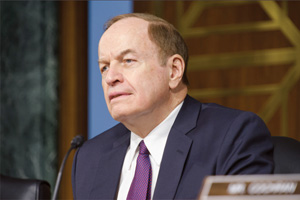Senior Reporter
Senate Panel Clears Twin 33s, Orders DOT to Move on E-Logs

This story appears in the June 29 print edition of Transport Topics.
WASHINGTON — Senate appropriators on June 25 included a provision as part of a fiscal 2016 transportation funding bill allowing the use of twin 33-foot trailers nationwide.
The provision, introduced as an amendment sponsored by Sen. Richard Shelby (R-Ala.), was adopted by a vote of 16-14, mostly along party lines. Sen. Jon Tester (D-Mont.) voted favorably on the amendment, while Appropriations Committee Chairman Thad Cochran (R-Miss.) opposed it.
The Senate language is similar — but not the same — to language in the House-approved version of the bill.
Shelby argued his proposal to pave the way for mainstream use of larger twin trailers would improve safety along the nation’s highways, a sentiment echoed by Sen. Susan Collins (R-Maine), chairman of the Transportation, Housing and Urban Development, and Related Agencies Appropriations subcommittee.
“I believe that lengthening truck trailers would make our highways safer while also saving resources,” Shelby said.
The $55.6 billion funding bill passed 20-10. Overall, it would provide $572 million for the Federal Motor Carrier Safety Administration’s operating budget for fiscal 2016 as well as $500 million for a high-profile infrastructure grants program.
Republican leaders who manage the floor have yet to indicate when the bill would be considered before the full Senate.
Shelby’s amendment also would allow state transportation departments as well as governors to request exemptions to the provision if they are incapable of safely accommodating trucks with twin 33-foot configurations.
The amendment also would direct the U.S. transportation secretary to update Congress three years after the bill’s enactment on a crash-data analysis comparing twin 28-foot trailers and twin 33-foot trailers. The secretary also would be required to recommend technologies, such as collision avoidance and stability control, that would improve safety.
Many Democrats on the committee, however, disagreed with Shelby’s assessment, arguing that longer trailers would not make highways safer. They also noted that Shelby’s provision drew opposition from the National Association of Police Organizations, the National Troopers Coalition, the National Sheriffs’ Association, the International Association of Chiefs of Police and other law-enforcement entities.
Prior to the vote on Shelby’s amendment, Sen. Dianne Feinstein (D-Calif.) sought unsuccessfully to undo Shelby’s efforts by offering her own amendment and urging the panel to reject his proposal.
“On some of the busiest highways with literally millions of cars . . . we’re going to put an 80-foot-long truck,” Feinstein warned colleagues.
The bill also would require the U.S. Department of Transportation to complete its final rule on electronic logging devices and its proposed rule on speed limiters this year.
FMCSA has indicated it plans to issue a final electronic logging device rule by the fall. The National Highway Traffic Safety Administration also is planning to release a speed-limiter proposal for heavy trucks.
The legislation also includes provisions related to an hours-of-service restart rule. As of press time, text of the legislation was not made available to the public.
Additionally, the bill would allow certain larger trucks to continue using stretches of Interstate 69 after it is incorporated into the interstate system. An amendment to the bill would allow Kansas to seek exemption from federal truck size limits for certain agricultural vehicles during its harvest season.
“We know that FMCSA’s restart restrictions increased truck traffic during the daytime, leading to an increase in accidents, and we know that a modest increase in tandem trailer length will eliminate millions of truck trips annually,” said American Trucking Associations President Bill Graves. “Further, we know the leading causes of truck crashes are the actions of other vehicles, so the best way to eliminate crashes on our highways is to limit interactions between trucks and cars. This bill takes steps to do that.”
On June 9, the House passed a fiscal 2016 appropriations bill, which included a provision that would allow twin 33-foot trailers on U.S. highways. It also included new requirements to a study on the HOS restart rule.

